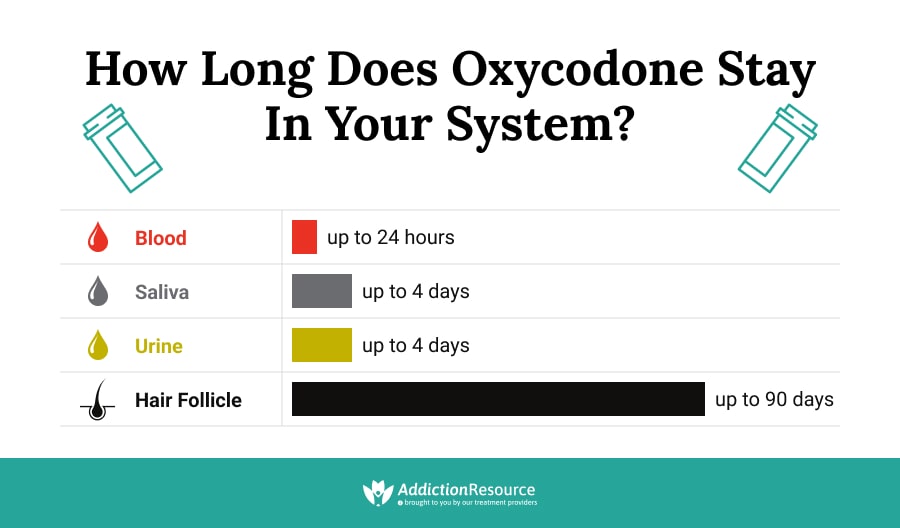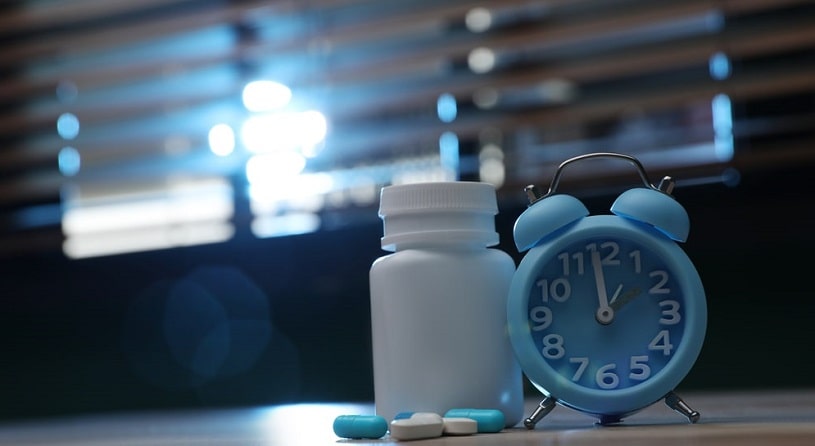Oxycodone is a drug initially invented to relieve pain emanating from several conditions. Some of these include cancer, heart problems, and so on. Despite its usefulness, it is also regarded to be dangerous when consumed in excess. This medication has been abused time and time again, with many people reaping the consequences every year. In the year 2019, about 50,000 people died due to opioid overdoses.
Table Of Contents:
How long does Oxycodone stay in your system? In most instances, it’s connected to the frequency of intake, hydration level, body mass and weight, and height. Other factors that significantly affect the duration this medicine stays in the body are how well the kidney and livers are working, how acidic or alkaline urine is, and others.
How Long Does Oxycodone Stay in Your System?
There are a variety of tests to confirm the presence of this medicine in the system. Now all these tests have various durations (after ingestion) where they would pick out this medicine if it exists in the body.
Blood
The blood will test positive for this medicine 24 hours after one has taken it in. Such blood tests for this medication and its metabolites come in useful during tests for drug abuse, even up to clarifying poison claims in a death investigation.
Urine
Usually, the urine tests positive for this opiate up to four days after it has been taken. Generally speaking, urine tests are the most common drug tests used by individuals, businesses, and companies. That is because Oxycodone levels in urine are easy to detect.
The individual who took the test would begin to test positive for the drug after about one hour of taking it, depending on the Oxycodone levels in urine samples.
Saliva Or Sweat
The saliva Oxycodone drug test is one quick test to check for the presence of this opiate in one’s body. It shouldn’t stay more than four days in saliva.
Hair
When it comes to an Oxycodone drug test, it can be found in hair the longest. Someone who has used this drug recently can expect to test positive. Frequent users test positive for up to 90 days after the last usage.

How is Oxycodone Metabolized?
Because Oxycodone 5mg is an opioid, it is also metabolized quite similarly. However, something essential to keep in mind is that the metabolism of this drug is different for many individuals. For example, some people can respond to and metabolize this drug in a few hours or under a day, while others need more than one day.
This medication’s metabolism occurs mainly in the gastrointestinal tract. When the drug enters the body, it begins to undergo hepatic metabolism. It will break its constituents down into metabolites, which the body can easily absorb. The enzymes responsible for this are the CYP450 isoenzymes. The metabolites are then converted into hydrophilic substances. Now, the drug can begin to act on its target tissues by moving in and out of cell membranes.
How Does It Work?
When this opioid is administered into the body, it binds to the opioid receptors mu, kappa, and delta, found in a human’s central nervous system. However, the mu receptor is the best respondent to this drug. It leads to a reduction in the excitation of neurotransmitters responsible for transmitting feelings of pain.
Because it is a potent CNS depressant, mixing it with other depressants can lead to a deadly overdose. Oxycodone overdose death is entirely possible, given the drug’s mechanism of action.
How Long Does Oxycodone Last?
Under normal circumstances, this opiate tends to last about 4-6 hours after taking the drug. Capsules and liquids work relatively faster. It only takes about half an hour for the system to feel its effects. Tablets work somewhat slower, as it can take about 24 to 48 hours to feel full effects. If the dosage is an extended-release type, its effects last for half a day.

However, the numbers will be completely different if a patient engages in snorting Oxycodone. With this administration route the effects kick in and reach their peak much faster.
People who abuse Oxycodone can feel its effects for up to 6-12 hours, depending on how it is ingested. The Oxycodone half-life ranges from 3 to 5 hours. As a result, withdrawals from Oxycodone will start about 12 hours after the last dose.
The Oxycodone half-life means the duration it would take for exactly half of its components to be expelled from the body. This means that if the person took the required, regular dose of this opiate, the half-life would be between the 3-5 hour range. However, this duration should not always be followed. As mentioned previously, the half-life of Oxycodone that remains present in the human body depends on several other factors.
Factors That Influence the Duration of OxyContin in System
The amount of time this opiate is going to stay in the system depends on many factors. So, for people asking “how long does Oxycodone last,” below are a few of them:
Metabolism
One major determinant of the length of residence of this opiate is metabolic rate. If the subject’s body processes materials fast, then it is sure to leave the body in a relatively shorter time.
Age
Age also has a significant role to play. Elderly patients will not be able to excrete drugs at the pace of a younger person. It is understandable as being advanced in age could weaken the effectiveness of the kidney or liver. Overall, this would eventually slow down the metabolic process.
Moreover, age also influences the intensity of adverse reactions. The older the person is, the more likely they are to experience OxyContin side effects.
Weight and Body Mass
The weight and body mass are also significant in determining Oxycodone half-life. Fatty tissues have an increased probability of retaining chemicals when measured against lean muscles, so carrying more fat may translate into the slower passage of this drug. The more hydrated a person is, the bigger the chances that this opiate will clear quickly.
Urinary PH
Another contributor is urinary pH. When there is more alkalinity in urine, it becomes more likely that this medicine will remain in the body before it clears.
Lastly, one crucial factor that essentially dictates the half-life of Oxycodone is the regularity of ingestion. Indeed, if the person has been taking it for a while, there is the possibility that it could accumulate in some parts of their system. Also, if one had taken it in a high quantity, such drugs could take longer to leave the body.
Addiction Treatment
This medication is a drug that can be helpful but also dangerous if taken the wrong way. It works closely with the brain and nerves to reduce pain, and its effects can be felt within a few minutes to an hour, depending on a person’s body chemistry.
Addiction is a hazardous condition to experience, and the treatment of this medicine can be challenging. For people exhibiting minor symptoms of addiction, help can be given in the form of therapy and support help. However, people with more severe addiction symptoms may need to be rehabilitated for a chance of recovery.
Frequently Asked Questions
How Long Does Oxycodone Take to Work?
This medication is a drug that takes 30 minutes to 1 hour to work, based on when and how a patient took it. Fast-acting medication types take only about an hour to work, while extended-release types take up to 2 days to feel the full effects.
What Is the Best Way to Get Oxycodone Out of Your System?
There is no straightforward way to get excess Oxycodone out of your system. If used recreationally, it should be stopped immediately. Although some reports say exercise and diet may help, these facts have not been thoroughly researched.
Will Oxycodone Test Positive for Opiates?
Yes, it will test positive for opiates. That is because this drug is also an opioid and thus, contains the components required to test positive for opiates.
It can be detected in urine samples for about 2 to 4 days, depending on the frequency of previous use. It can be detected in saliva tests, the second most common form of drug tests, for about four days.
Hope Without Commitment
Find the best treatment options. Call our free and confidential helpline
Most private insurances accepted
Page Sources
- Ciccarone, D. (2019). The triple wave epidemic: supply and demand drivers of the US opioid overdose crisis. The International journal on drug policy, 71, 183. https://www.ncbi.nlm.nih.gov/pmc/articles/PMC6675668/
- Chidambaran, V., & Senthilkumar Sadhasivam, M. M. (2017). Codeine and opioid metabolism–implications and alternatives for pediatric pain management. Current opinion in anaesthesiology, 30(3), 349. https://www.ncbi.nlm.nih.gov/pmc/articles/PMC5482206/
- Rajiv Balyan, Marc Mecoli, Raja Venkatasubramanian, Vidya Chidambaran, Nichole Kamos, Smokey Clay, David L Moore, Jagroop Mavi, Chris D Glover, Peter Szmuk, Alexander Vinks, Senthilkumar Sadhasivam. CYP2D6 pharmacogenetic and Oxycodone pharmacokinetic association study in pediatric surgical patients. Pharmacogenomics. 2017 Mar; 18(4): 337–348. https://www.ncbi.nlm.nih.gov/pmc/articles/PMC5558529/
- Byung‐Moon Choi, Yong‐Hun Lee, Sang‐Mee An, Soo‐Han Lee, Eun‐Kyung Lee, Gyu‐Jeong Noh. Population pharmacokinetics and analgesic potency of Oxycodone. Br J Clin Pharmacol. 2017 Feb; 83(2): 314–325. https://www.ncbi.nlm.nih.gov/pmc/articles/PMC5237696/
- Bernhard Scheidel, Martina A. Maritz, Yves J. Gschwind, Kerstin Steigerwald, Volker Guth, Peter Kovacs, Helene Rey. Bioavailability of Oxycodone after administration of a new prolonged-release once-daily tablet formulation in healthy subjects compared to an established twice-daily tablet. Int J Clin Pharmacol Ther. 2017 Nov; 55(11): 881–890. https://www.ncbi.nlm.nih.gov/pmc/articles/PMC5729229/
- Gallego, A. O., Baron, M. G., & Arranz, E. E. (2007). Oxycodone: a pharmacological and clinical review. Clinical and Translational Oncology, 9(5), 298-307. https://pubmed.ncbi.nlm.nih.gov/17525040/
- Sadiq NM, Dice TJ, Mead T. Oxycodone. [Updated 2021 May 19]. In: StatPearls [Internet]. Treasure Island (FL): StatPearls Publishing; 2021 Jan https://www.ncbi.nlm.nih.gov/books/NBK482226/

 Authored by
Authored by  Reviewed by
Reviewed by 

